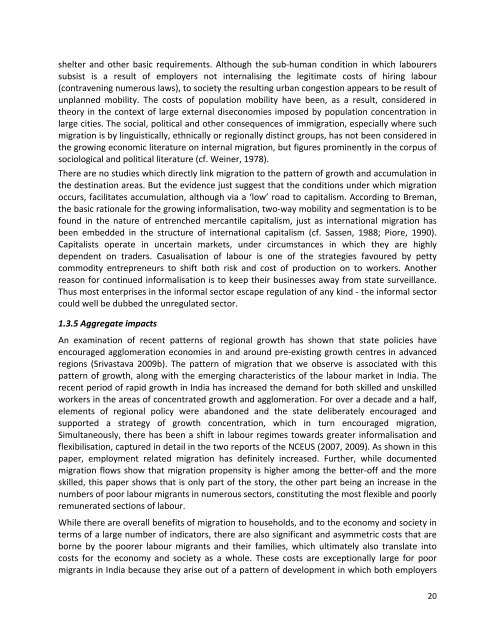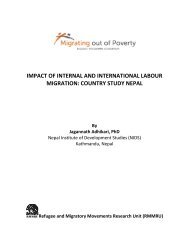workingpaper41 - Refugee and Migratory Movements Research Unit
workingpaper41 - Refugee and Migratory Movements Research Unit
workingpaper41 - Refugee and Migratory Movements Research Unit
You also want an ePaper? Increase the reach of your titles
YUMPU automatically turns print PDFs into web optimized ePapers that Google loves.
shelter <strong>and</strong> other basic requirements. Although the sub‐human condition in which labourers<br />
subsist is a result of employers not internalising the legitimate costs of hiring labour<br />
(contravening numerous laws), to society the resulting urban congestion appears to be result of<br />
unplanned mobility. The costs of population mobility have been, as a result, considered in<br />
theory in the context of large external diseconomies imposed by population concentration in<br />
large cities. The social, political <strong>and</strong> other consequences of immigration, especially where such<br />
migration is by linguistically, ethnically or regionally distinct groups, has not been considered in<br />
the growing economic literature on internal migration, but figures prominently in the corpus of<br />
sociological <strong>and</strong> political literature (cf. Weiner, 1978).<br />
There are no studies which directly link migration to the pattern of growth <strong>and</strong> accumulation in<br />
the destination areas. But the evidence just suggest that the conditions under which migration<br />
occurs, facilitates accumulation, although via a ‘low’ road to capitalism. According to Breman,<br />
the basic rationale for the growing informalisation, two‐way mobility <strong>and</strong> segmentation is to be<br />
found in the nature of entrenched mercantile capitalism, just as international migration has<br />
been embedded in the structure of international capitalism (cf. Sassen, 1988; Piore, 1990).<br />
Capitalists operate in uncertain markets, under circumstances in which they are highly<br />
dependent on traders. Casualisation of labour is one of the strategies favoured by petty<br />
commodity entrepreneurs to shift both risk <strong>and</strong> cost of production on to workers. Another<br />
reason for continued informalisation is to keep their businesses away from state surveillance.<br />
Thus most enterprises in the informal sector escape regulation of any kind ‐ the informal sector<br />
could well be dubbed the unregulated sector.<br />
1.3.5 Aggregate impacts<br />
An examination of recent patterns of regional growth has shown that state policies have<br />
encouraged agglomeration economies in <strong>and</strong> around pre‐existing growth centres in advanced<br />
regions (Srivastava 2009b). The pattern of migration that we observe is associated with this<br />
pattern of growth, along with the emerging characteristics of the labour market in India. The<br />
recent period of rapid growth in India has increased the dem<strong>and</strong> for both skilled <strong>and</strong> unskilled<br />
workers in the areas of concentrated growth <strong>and</strong> agglomeration. For over a decade <strong>and</strong> a half,<br />
elements of regional policy were ab<strong>and</strong>oned <strong>and</strong> the state deliberately encouraged <strong>and</strong><br />
supported a strategy of growth concentration, which in turn encouraged migration,<br />
Simultaneously, there has been a shift in labour regimes towards greater informalisation <strong>and</strong><br />
flexibilisation, captured in detail in the two reports of the NCEUS (2007, 2009). As shown in this<br />
paper, employment related migration has definitely increased. Further, while documented<br />
migration flows show that migration propensity is higher among the better‐off <strong>and</strong> the more<br />
skilled, this paper shows that is only part of the story, the other part being an increase in the<br />
numbers of poor labour migrants in numerous sectors, constituting the most flexible <strong>and</strong> poorly<br />
remunerated sections of labour.<br />
While there are overall benefits of migration to households, <strong>and</strong> to the economy <strong>and</strong> society in<br />
terms of a large number of indicators, there are also significant <strong>and</strong> asymmetric costs that are<br />
borne by the poorer labour migrants <strong>and</strong> their families, which ultimately also translate into<br />
costs for the economy <strong>and</strong> society as a whole. These costs are exceptionally large for poor<br />
migrants in India because they arise out of a pattern of development in which both employers<br />
20



